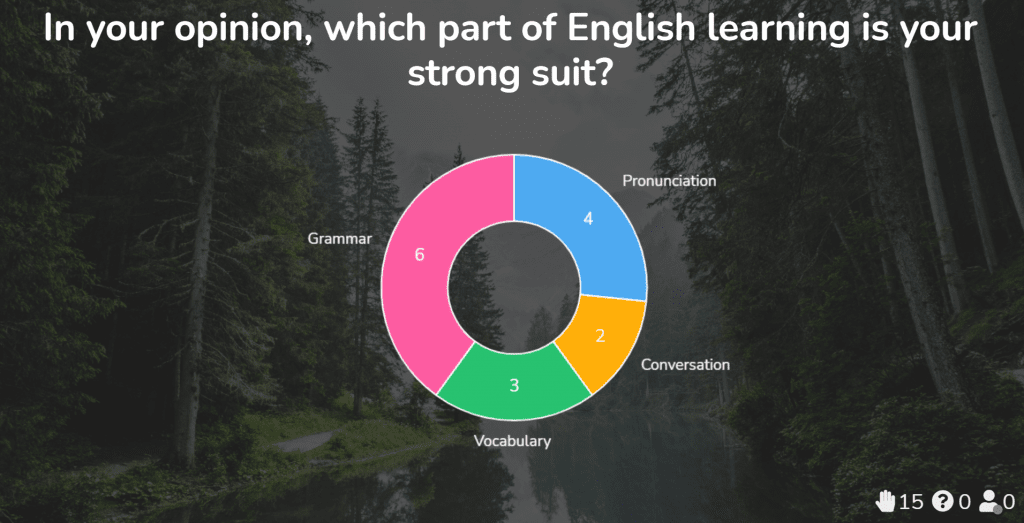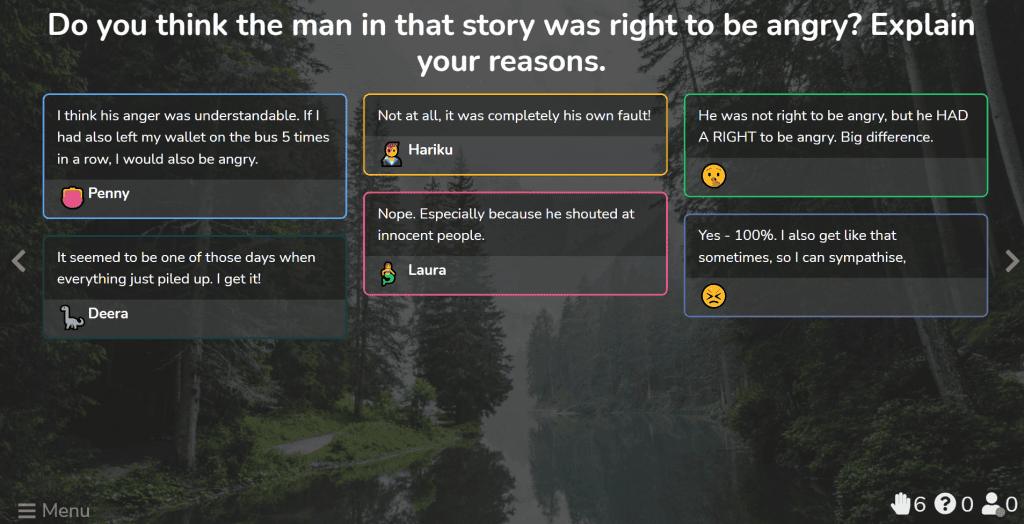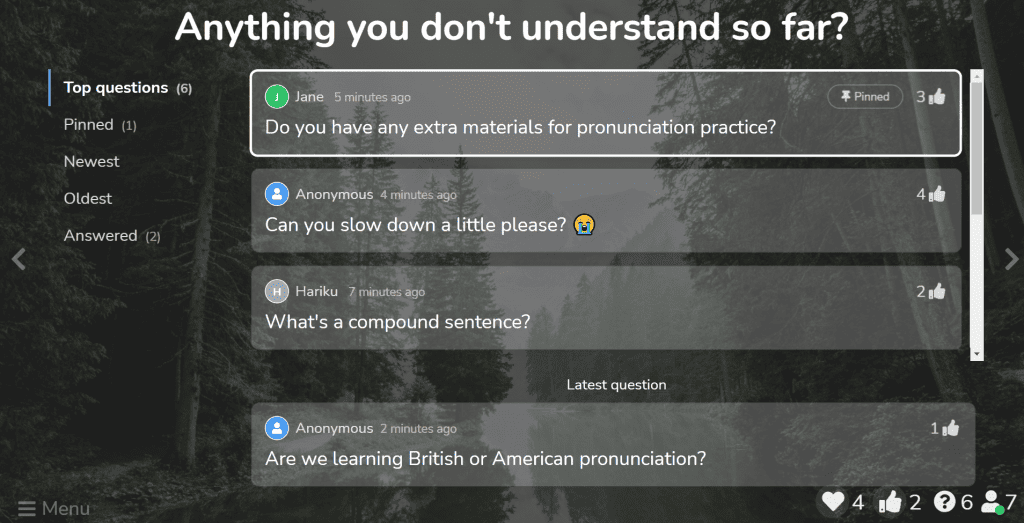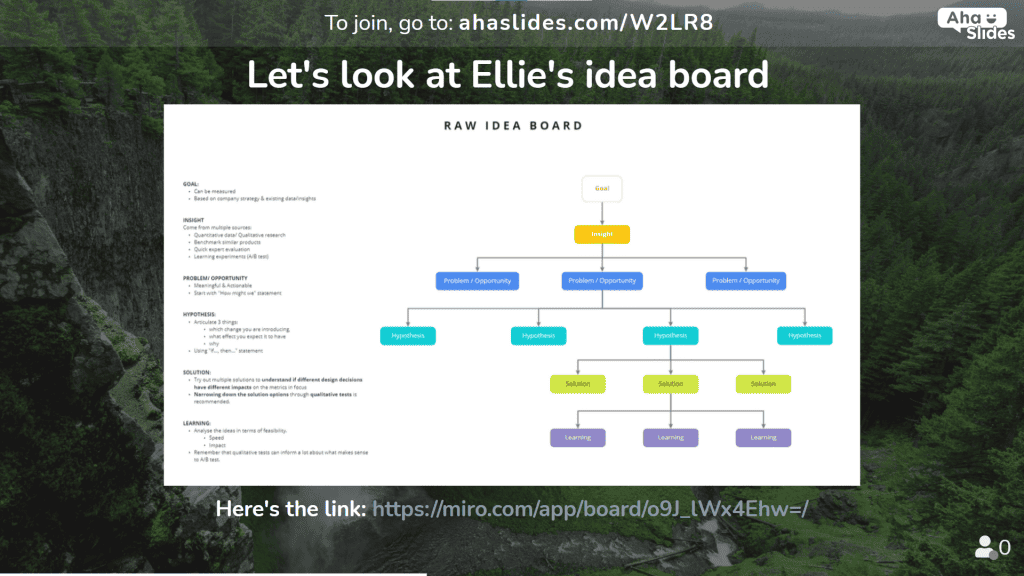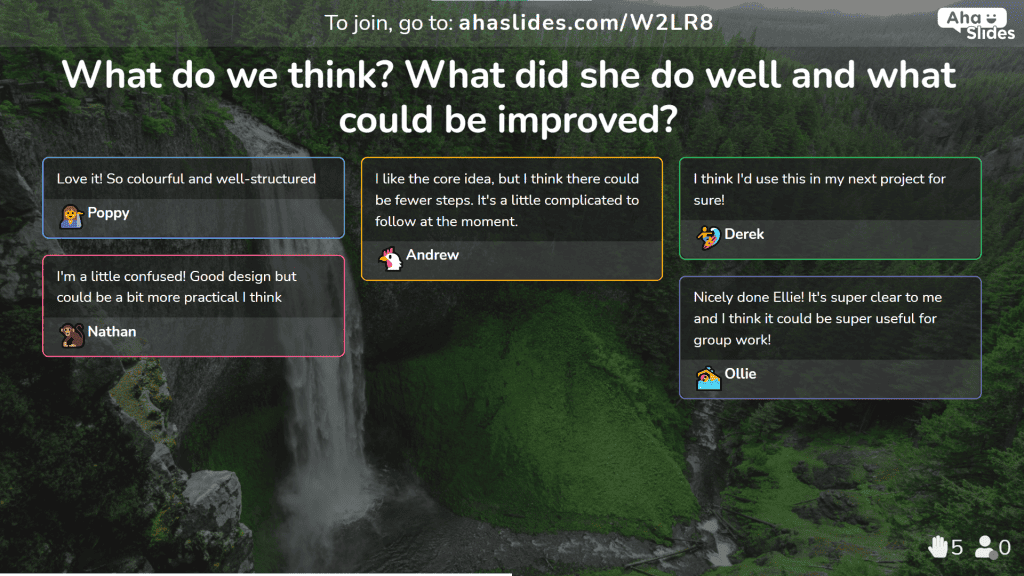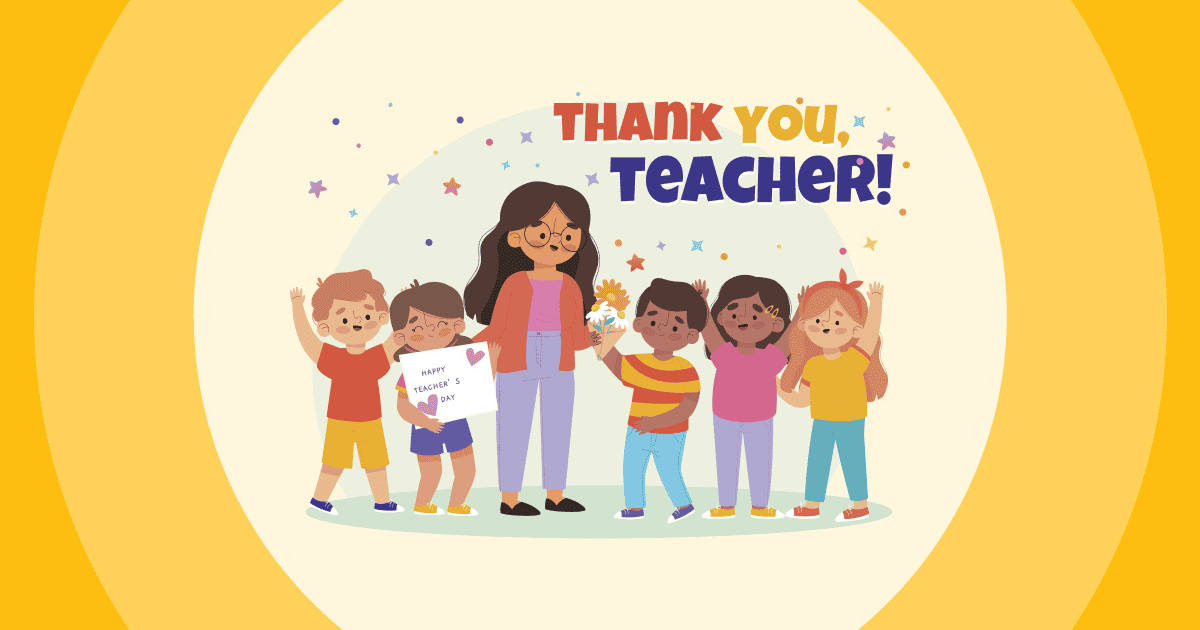よく耳にする言葉です。「優れた教師は優れた動機付けの力を持つ」。これは単純な考えですが、教育者たちが何十年も議論してきた概念に基づいています。 どうすれば生徒のやる気を引き出すことができますか?
まあ、やる気のなさはやる気のなさを生みます。生徒のやる気を引き出せなければ、 どうすれば彼らに教えるように動機付けることができますか?
これは悪循環ですが、 学生の教室での取り組み 一連の インタラクティブな教室活動 以下の方法は腐敗を止めるのに役立ちます。
生徒の授業参加を高める方法 – ガイド
- なぜ生徒の教室の関与が重要なのですか?
- #1 – 生徒の意見を活用する
- #2 – 話をさせよう
- #3 – クイズ付き品種コンテスト
- #4 – Q&Aチェックポイントを設定する
- #5 – 教えてもらう
- #6 – スタイルをミックスする
- #7 – 関連性を持たせる
- #8 – 選択肢を与える
- #9 – テクノロジーを活用する
- #10 – 脚本をひっくり返す
- #11 – ギャラリーを散策する
- #12 – グループワークを決して放棄しない
AhaSlidesを使った教室運営のヒント
- 教室運営戦略
- オンライン教室での生徒の参加を向上させる方法
- 革新的な教授法
- 14 年の学校や職場でのブレインストーミングに最適な 2024 のツール
- アイデアボード | 無料のオンライン ブレーンストーミング ツール
- ランダムチームジェネレーター | 2024年のランダムグループメーカーが明らかに

数秒で開始します。
究極のインタラクティブな教室活動のための無料の教育テンプレートを入手してください。 無料でサインアップして、テンプレート ライブラリから必要なものを取得してください!
🚀 無料のテンプレートを入手☁️
なぜ生徒の教室の関与が重要なのですか?
学習意欲の低い生徒は救いようがないと決めつけたり、「生徒のエンゲージメント」なんて時間に余裕のある教師のための概念だと片付けたりするのは簡単です。しかし、このテーマに深く踏み込むことで、生徒のやる気を引き出そうとする意欲を示したことになります。そして、それはやる気を引き出す力になります!
生徒の学習向上に向けて、正しい一歩を踏み出しました。課題の支援が必要な生徒は、最高の指導員に助けを求めることを検討してください。 エッセイ ライティングサービス。これらのサービスは、ライティングスキルを磨き、学業を確実に成功させるための貴重なサポートを提供します。
- アメリカの学生の53%は エンガではないゲド or 積極的に解放 レッスンで。 ((ギャラップ)
- 2020学年度の終わりまでに、1.3万人の学生が従事を停止しました 遠隔学習への切り替えのため。 (リマインド)
- 熱心な学生は、自分が得たと結論付ける可能性が2.5倍高くなります 学校で優秀な成績。 (ギャラップ)
学習意欲の低下は蔓延していますが、それを止める方法は常に存在します。以下のヒントは、オフラインでもオンラインでも、生徒の学習意欲を再び呼び起こすのに役立ちます。 オンライン学習学生の関与
4つの簡単な勝利
以下のXNUMXつのテクニックは 最も速い および 最も簡単 生徒の興味を引き付ける方法。設定にほとんど手間がかからず、あらゆるレベルの生徒に簡単に理解できます。
#1 – 生徒の意見を活用する
世論調査は決定的な影響力を持っています。なぜなら、世論調査は、若者の世界の中心である彼ら自身と、調査対象を結び付けるからです。
もちろん、私は子供です。 それでも、それらを許可します 彼らの意見を投稿する 何かに、そして彼らの意見が周囲のシステム内にどのように適合するかを見て、 驚異を行うことができます 学生の注意のために。
レッスンに参加する声を生徒に与えることには多くの利点がありますが、それは生徒にそのことを知らせることに他なりません。 アプリ環境に合わせて 意見ではなく 主題は、ここでのショーの本当のスターです。
以下のこの質問を見てください。これはESLレッスンで尋ねることができます。
この投票は、次の理由でエンゲージメントに最適です。
- 質問はすべてについてです それら.
- 学生は自分の意見がどのようになっているのかを即座に確認できます 他の人と積み重なる 彼らの周り
- 教師であるあなたは、生徒についてこれまで知らなかった側面を知ることができます。
堅実で多様な世論調査から、戦略 2 が自然な次のステップになります...
#2 – 話をさせよう
アンケートよりも包括的な学習者エンゲージメント戦略が 1 つあります。 本格的な議論.
生徒に自分の微妙な意見を雄弁かつ慎重に表明させることは、教えることの究極の夢の XNUMX つです。 悲しいことに、この夢は教室の中で最高のラインを占めています。 誰も話しません および 絶対的な混乱.
この 技術が存在する理由です。
多くの教育技術ツールが奨励しています 書面による回答 自由形式の質問に、誰もが自分の声を聞いて物事を維持するのに役立ちます 完全に整然とした.
回答が送信されると、他のすべての回答と平等な競争の場に入ります。ボード上の同様に貴重な回答を順番に読み上げて議論を引き出します。
そして恥ずかしがり屋の子供たち? 彼らは匿名で答えを入力することができますつまり、書いた内容で批判される心配はありません。自意識過剰な生徒がいるクラスでは、匿名で回答できるというシンプルさが、生徒の学習意欲を驚くほど高める要因となります。
もっと読むには? 💡 完全なガイドはこちら 6つのステップで学生の討論を行う方法!
#3 – クイズ付き品種コンテスト
競争の張り出した力は、教師にとって絶対的な金粉です。 残念ながら、無計画で最終的には無意味なスター報酬システムを除けば、学生の教室でのエンゲージメント戦略としての競争はまだ十分に活用されていません。
どのような見解を持っていても、競技会は教育に多くのものをもたらすことができます。そして、より広く受け入れられるべきです。
トム・フェルフーフ博士、アイントホーフェン工科大学。
大人になってからよく参加する、最も魅力的な競争の一つは何でしょうか?私のような人なら、それはライブクイズでしょう。ここで言うクイズとは、試験やテストのことではありません。リーダーボードがあり、楽しく、ドラマチックで、参加者が大勢集まる、質の高いクイズのことです。
ソロでもチームでも、仲間と競争する学生のラッシュは、エンゲージメントの旋風になる可能性があります。 賭け金が高い場合 (つまり、賞品が良い場合)、クイズは、このリストの中で最も効果的な生徒のクラス参加テクニックの XNUMX つになる可能性があります。
優れた教育クイズを作成するためのヒントを次に示します。
- 約10の質問にそれを保ちます – 生徒たちに熱中させつつも、飽きさせないようにしてください。
- 難易度を混ぜる – 全員を緊張させておきましょう。
- 利用技術 – 私の個人的な経験では、大きなクラスでは紙とペンを使ったテストは管理が難しいです。 プロフェッショナルなエドテック ソフトウェア.
原型 👊 物事を混ぜ合わせる スピナーホイール。次のようなさまざまな形式を試すことができます。 ミリオンダラーレース、またはクイズのおまけとして使用してください!
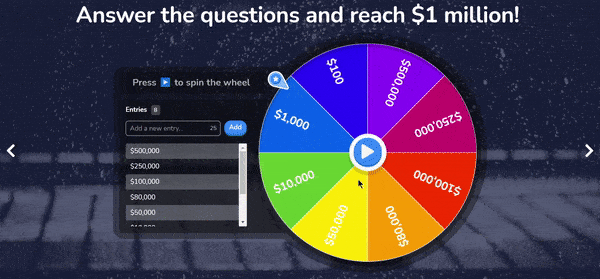
#4 – Q&Aチェックポイントを設定する
離脱の最大の原因の一つは行動ではなく、 理解教材の質に関係なく、生徒が理解できなければ、あなたは教室の全員のぼんやりした顔を眺めるだけになるでしょう。
確かに、新しい概念についての説明が理解できたかどうかを生徒に尋ねることはできますが、自意識過剰な生徒のうち何人がみんなの前で理解できていないことを認めるでしょうか?
エドテックの時代における答えは、 Q&Aチェックポイントこれが機能する理由です:
- 彼らは匿名だ – 生徒は匿名のまま、恐れることなく何でも質問することができます。
- 詳細な – 生徒は理解していない点をじっくり考える時間を持つことができます。
- 彼らは組織的だ – すべての回答は書き込まれ、さまざまなカテゴリに分類され、永続的に保存されます。
発火する 本当の学習。
上記のすべての戦略を無料でお試しください。 オンラインまたはオフラインの教室でインタラクティブになりましょう!
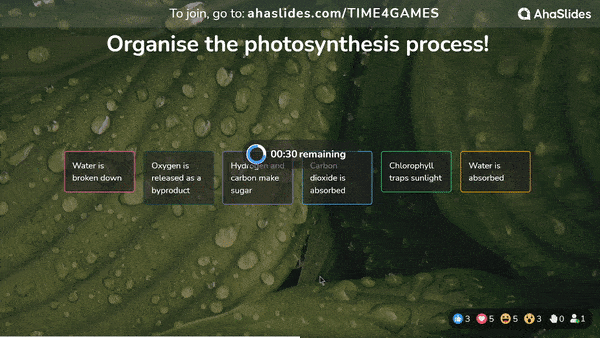
4ロングプレイ
これらの4つのテクニックは少し長くなります。指導方法に小さな変化を加えるだけで、 理解して設定する時間.
それでも、一度ロッカーに入れてしまえば、これらは教室で使用できる最も魅力的なテクニックの一部になる可能性があります。
#5 – 教えてもらう
教室離れの悲劇の一つは、 学校の宿題の85% 厳格すぎて、より高度な思考スキルを受け入れることができません。 これは、制限のあるシラバスよりも高く考えているにもかかわらず、多くの場合、レッスンを魅力的にするものです.
これは教師だけで克服するのは難しいですが、生徒に 主題の一部を教える責任 素晴らしい治療法です。

自分の教師のトレーニングに戻ります。 行動管理に関する教科書の演習中、または観察された実践中に若い顔の海に直面しているときに、より熱心に取り組んでいましたか? どの時点で、より高いレベルで考え、操作していましたか?
生徒を教師に変えるためのヒントをいくつか紹介します。
- 徐々にやってください。 これが生徒の授業への取り組みにおいて「長期的な」戦略であるのには理由があります。生徒は、たとえ少人数のグループであっても、何かを教えるには時間と練習が必要です。年間を通して練習時間を分散させるようにしましょう。
- 時間を計ってください。 彼らを圧倒しないように、教えるために短い時間枠を与えてください。 教えるときは、時計に目を光らせて、時間が教えることの重要な要素であることを子供たちが理解できるようにします。
- あなたの期待を高めます。 多くの場合、学生は次のことができます。 方法 私たちが彼らに信用を与える以上のもの。 彼らに挑戦を与え、彼らがそれに会うのを見てください。
#6 - あなたのスタイルを混ぜる
学習スタイルへの多くのアプローチは、教師トレーニングの基本です。 確かに私たちはそれらを知っていますが、私たちが魅力的だと思う限り ビジュアル, 聴覚の および キネティック 学習者の場合、中心となる学生グループの少なくとも 1 つが不合格になる可能性が高いです。
運動感覚型学習者であれば、毎週の象徴的な実践活動だけでは不十分です。聴覚型学習者には、学期ごとに2回以上のディスカッションが必要です。 一貫した刺激 レッスンに従事し続けるために。

それぞれのレッスンで、 学習スタイルごとに少なくともXNUMXつのアクティビティこれらは…
- 概念を説明したり、メモを取ったり、ビデオを見たり、クイズをしたり、 (ビジュアル)
- ポッドキャストを聴いたり、ディスカッションしたり、音読したり、音楽を作ったり、 (聴覚)
- 実験をしたり、何か物理的なものを作ったり、ロールプレイをしたり、教室内を動き回ったり… (運動感覚)
覚えておいてください。大変な作業かもしれませんが、その価値はあります。レッスンが予測不可能になるにつれて、生徒たちはより長く集中して聞くようになります。
原型 👊 各生徒の学習スタイルを定義する これらの25の質問.
#7 – 関連性を持たせる
ベトナムで英語を教えていたとき、すべての教科書がイギリスやアメリカの文化だけを参照していることに気づきました。 による 全国英語教師評議会(NCTE)、私のベトナム人の生徒たちはレッスンで自分たちの文化に関連するものを何も見つけられなかったので、彼らは無視する可能性がはるかに高かった.
問題は文化だけにとどまりません。授業に生徒が共感できるものが何もなければ、一体なぜそのテーマを学ぶ必要があるのでしょうか?
特にXNUMX代の学生にとって、あなたのトピックを彼らの興味に関連する何かとリンクさせることは多かれ少なかれ不可欠です。
これらの興味を発見することは、 簡単な調査。 90年代、コネチカット州 Interest-a-Lyzerと呼ばれるものを実行しました 公立学校では、長すぎて長すぎます 90s 現代の使用のために、それが尋ねる質問はあなたの調査に使用することができます. (これには、優れたライティングの練習になるというボーナスもあります!)
生徒から回答が得られたら、生徒の興味に合わせて説明や演習を調整できます。
#8 – 選択肢を与える
年長の生徒の場合、すべての活動に必要なものが XNUMX つあります。関連性 (これについては先ほど説明しました) と選択です。
あなたの学生が世界で自分の道を見つける時代に、t彼の選択がすべてです. 学習者が教育を選択できることはめったにありませんが、教室で選択できるようにすることで、生徒のモチベーションを驚くほど高めることができます。
選択を教室に組み込むいくつかの方法は次のとおりです。
- アクティビティ – 練習としてたくさんのアクティビティを提供し、生徒に選択させます。
- Structure – レッスンの構造を説明し、生徒がどのように進めたいかを選択できるようにします。
- 装飾 – 教室のレイアウトについて生徒に意見を言わせましょう。
選択肢を授業にゆっくりと取り入れていくのが最善です。多くの生徒は学校でも、そしておそらくは人生においても、選択肢があまりにも乏しいため、教室でそれがどのように機能するのかよく分かっていないことがよくあります。
もっと読むには? 💡チェックアウト この優れたアカウント 教師がどのように選択肢を提供することで生徒の集中力を高めたかについて。
オンライン学習のための4
オンライン学習はますます普及しつつありますが、学生の意欲を遠く離れた場所で維持することはますます困難になっているようです。
ここにあなたの中で何か違うことを試すための4つのヒントがあります リモート教室、またはすることができます ここでもっとたくさん入手してください!
#9 – テクノロジーを活用する
2020年にほぼすべての授業がオンラインになったとき、教師たちが慣れ親しんだオフライン授業の手法に固執する傾向があったのは当然のことでした。それは初期の段階では通用しましたが、今は通用しません。
豊富な教育用、創造的、共同作業用ツールは、仮想教室に革命をもたらしました。 コロナウイルスの黎明期には、教師も生徒も夢にも思わなかったようなことをする方法があります。

ここにいくつかあります 無料です。 教師と生徒がオンラインレッスンで使用できるツール:
- コンテンツを知る X 📊
学生がトピックを主催し、作成できるインタラクティブなプレゼンテーション メーカー ライブ投票, オンラインクイズ そしてそれについてブレインストーミングするのです。 革新的な教授法 教師たちの社交界で話題になっている。 - カラーシンチ ????
シンプルだが強力な写真編集およびグラフィック デザイン ソフトウェア。 Colorcinch には、ベクター グラフィックス、ストック フォト、および特殊効果の豊富なコレクションがあります。 - Canva 甘いもの<XNUMXxXNUMX><XNUMXxXNUMX><XNUMXxXNUMXC>
画像、ポスター、パンフレット、パンフレットなどを作成する簡単な方法です。Canva には、構築するためのテンプレートと既製の要素の膨大なライブラリがあります。 - ミロ 🗒️
学生がブレインストーミングに使用できる共同ホワイトボードは、思考プロセスを説明し、ソリューションを相互に同時に設計します。 - フリップグリッド 📹
教師が質問をしたり、生徒からビデオ応答を受け取ったりできるビデオプラットフォーム。
ある程度の年齢の生徒はテクノロジーに自然な好奇心を持っているため、テクノロジーを取り入れることは学習意欲を高めるための最適な戦略となり得ます。ただし、やり過ぎには注意が必要です。一度に多くの新しいツールを導入すると、生徒の集中力が散漫になる可能性があります。
#10 – 脚本をひっくり返す
「反転学習」 生徒が自宅で概念を学び、授業時間を利用して学習した概念に関連する問題を積極的に議論し、解決していくことを指します。通常の学校の勉強と宿題の関係を…ひっくり返したようなものだと考えてください。
学業と宿題が同じ机で行われる遠隔教育の世界では、反転学習は、同期作業(ライブ教師と)と非同期作業(ライブ教師なし)の役割を交換することです。
遠隔教育における反転学習革命を示唆する証拠は数多くある。最も心強い統計の一つは、 フリップラーニングネットワークからの調査 – この方法を試した教師の80%が 学生のモチベーションの向上.
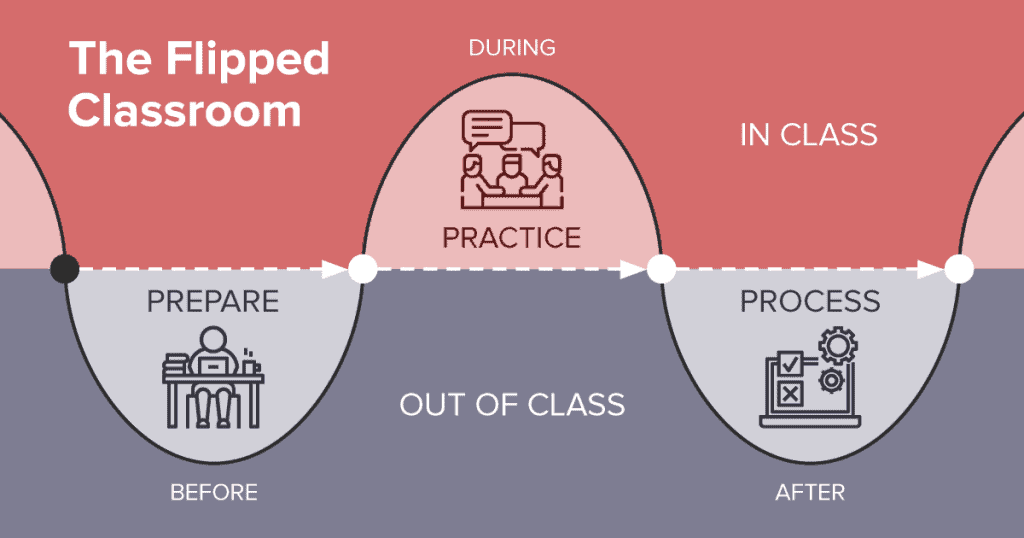
どうして? 生徒の参加を増やすための反転学習の利点のいくつかを確認してください。
- クラスでは、学生が参加できます 自分のペースで. 能力の低い生徒も高い生徒も、適切なレベルのタスクに集中できます。
- その他 自治 学生自身の学習に対する所有権の自由は学生に主導権を与え、これは大きな動機付け要因となります。
- 反転学習は学生に与えます 何かをする必要がある それらを情報の受動的な摂取者として扱うのではなく。 これにより、授業中の他の標準的なレッスンとは一線を画し、生徒が積極的に参加できるようになります。
試してみませんか?次回のオンライン クラスでこれを試してください。
- レッスン前: 学生向けのトピック資料(ビデオ、ポッドキャスト、録音された講義、読書リソースなど)の共有フォルダーを作成し、各資料を進めるように指示します。
- レッスン開始時: トピックの理解度を測定するための簡単なクイズを生徒に提供し、各生徒を理解度ごとにグループ化します。
- レッスン中: 各グループに刺激的な活動 (ディスカッション、コラボレーション、問題解決) を提示して、理解を固めます。
もっと読みたいですか? 💡 これをチェック 反転学習の素晴らしい入門書 レスレイ大学
#11 – ギャラリーを散策する
自分の作品が同世代の人たちに見られると知ったら、どれだけモチベーションが上がるでしょうか? きっとかなり上がるでしょう。それがギャラリーウォークのコンセプトです。
ギャラリーウォークとは、生徒たちが作品を互いに鑑賞し合うスライドショーです。生徒たちは作品を鑑賞しながら、観察し、作品に対する感想を書き留めます。
これが、生徒と教室の関わりを深める素晴らしいアクティビティである理由です。
- 増加します 学生の動機 彼らの固有の競争意識を通して。
- 増加します 学生の焦点 関係のない人ではなく、仲間の作品を見るからです。
- 増加します 学生の自由 表現の、それは常にモチベーションのためにポジティブです。
ギャラリー ウォークのセットアップは非常に簡単です。 以下のように、コメントを書き留める余地のあるプレゼンテーションを作成するだけです。
#12 – グループワークを決して放棄しない
遠隔学習への大規模な移行で道に迷ったすべての学習形式の中で、最大の犠牲者はグループワークでした。
学生が必要な時に 社会的相互作用とコラボレーション 結局、多くの教師はグループワークをオンラインの世界に移行するのは不可能だと判断しました。生徒たちは「学習」時間のほとんどを、クラスメイトから完全に孤立した状態で過ごしていました。
それは学習者のモチベーションに深刻な打撃を与えます。 これと戦うためのいくつかのグループワークのヒントがあります:
- Google ドライブなどのファイル共有ソフトウェアへのアクセスを許可します。
- Trelloなどのかんばんボード(タスク割り当て)ソフトウェアへのアクセスを提供します。
- Zoom やその他のビデオ通話ソフトウェアの「ブレイクアウト ルーム」を使用して、現実世界のグループ作業をシミュレートします。
- 大規模なプロジェクトを複数の小さなタスクに分割して、グループで完了します。
よくある質問
教室での生徒の関与をどのように測定しますか?
教室での生徒の関与を定量的および定性的に測定するには、次のようなさまざまな方法があります。
– 観察尺度 – 教師は、積極的な参加、アイコンタクト、一定の間隔で尋ねられる質問などの課題中の行動を客観的に記録します。
– 課題時間 – 生徒が授業活動に積極的に取り組んでいる合計時間と課題以外の時間の割合を追跡します。
– 生徒の自己報告 – 調査では、授業への注意、価値、楽しさに関する質問を通じて、認知的、行動的、感情的な関与を測定します。
– 宿題/課題 – 独立した作業の質と完了を評価することで、個人の取り組みに関する洞察が得られます。
– 参加ログ – 挙手やディスカッションへの貢献などの頻度を記録します。
– テストのスコア/成績 – 学業成績はエンゲージメントと関連していますが、それだけで決まるわけではありません。
– 教師の評価尺度 – アンケートにより、教師は授業や生徒の関与レベルを定性的に評価します。
– 非公式チェック – スキャフォールディングの質問への回答や、タスク中の会話トピックなど。
教室での参加にはどのような利点がありますか?
より熱心な生徒は、テストのスコア、プロジェクトの質、学習の定着率が高くなります。魅力的なレッスンは学習をより楽しくし、生徒に主体性を与え、内発的動機を刺激します。

